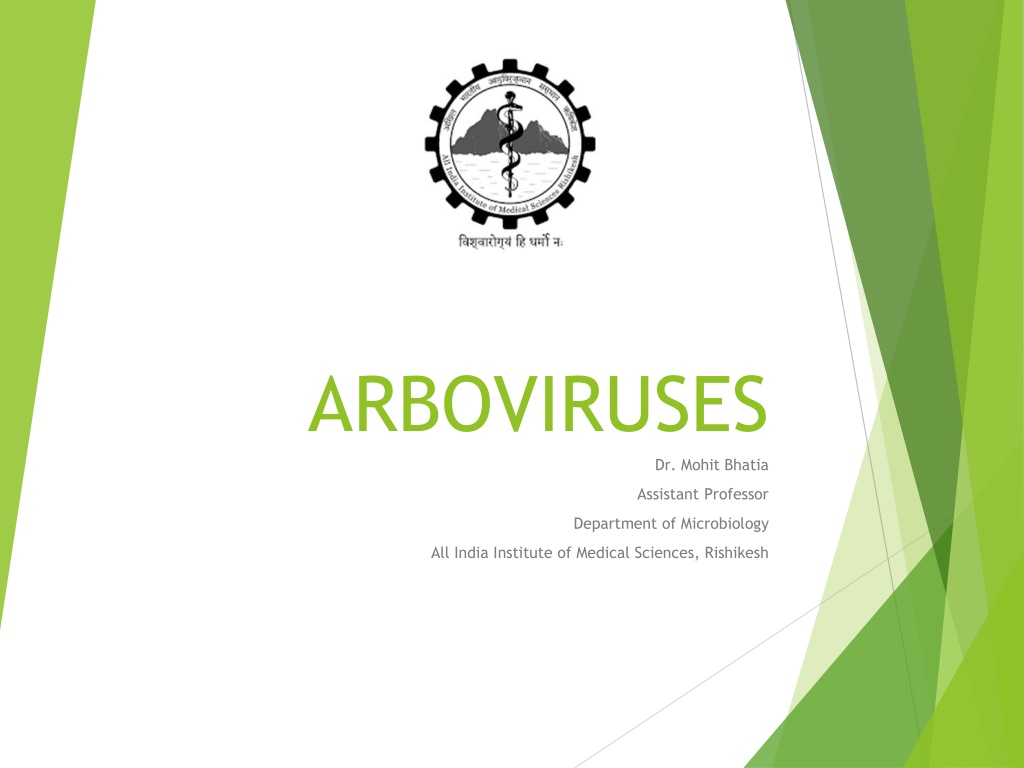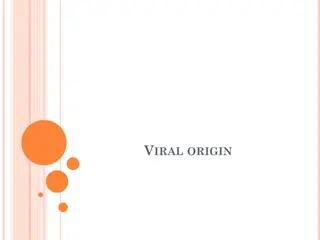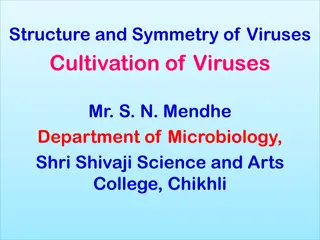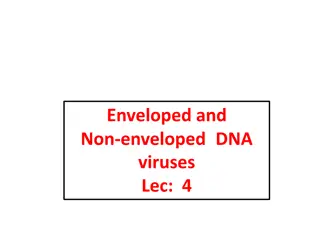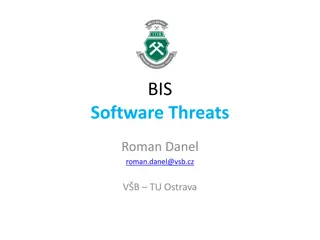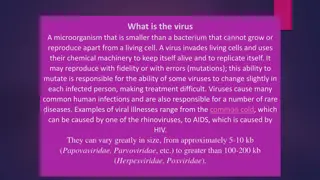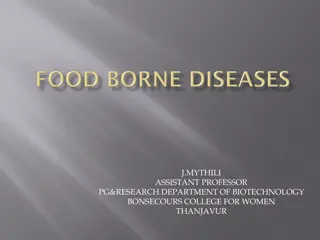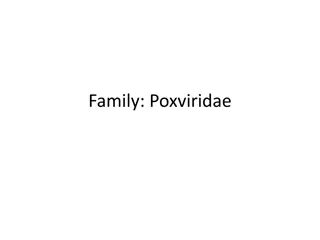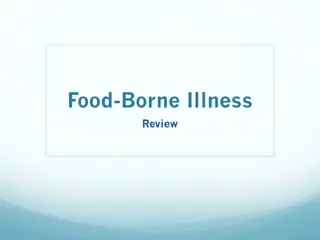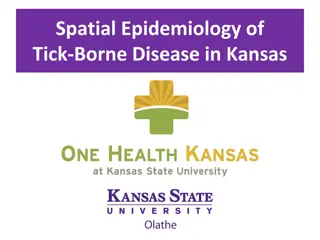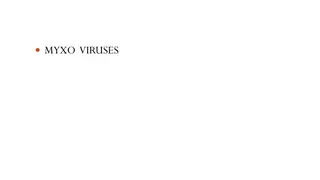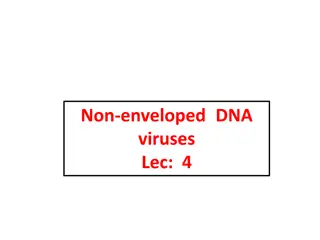Arboviruses: A Comprehensive Overview of Arthropod-Borne Viruses
Arboviruses, transmitted by bloodsucking arthropods, are a diverse group of RNA viruses with varied classifications like Togaviridae, Flaviviridae, Bunyaviridae, Reoviridae, and Rhabdoviridae. In India, Dengue, Chikungunya, and Japanese Encephalitis are prevalent arboviruses. Togaviridae, including Genus Alphavirus and Genus Rubivirus, exhibit specific morphological and replication characteristics. The pathogenic Genus Alphavirus viruses can be categorized based on clinical symptoms.
Download Presentation

Please find below an Image/Link to download the presentation.
The content on the website is provided AS IS for your information and personal use only. It may not be sold, licensed, or shared on other websites without obtaining consent from the author. Download presentation by click this link. If you encounter any issues during the download, it is possible that the publisher has removed the file from their server.
E N D
Presentation Transcript
ARBOVIRUSES Dr. Mohit Bhatia Assistant Professor Department of Microbiology All India Institute of Medical Sciences, Rishikesh
Definition: Arboviruses (arthropod-borne viruses) are diverse group of RNA viruses that are transmitted by bloodsucking arthropods (insect vectors) from one vertebrate host to another. Viruses must multiply inside the insects and establish a lifelong harmless infection in them. Viruses that are just mechanically transmitted by insects are not included in this group.
Arboviruses found in India Dengue, Chikungunya, and Japanese B encephalitis viruses are highly endemic in India
TOGAVIRIDAE- Classification Genus Alphavirus-Contains about 30 different mosquito borne viruses out of which about 13 are human pathogens. Genus Rubivirus -Contains rubella virus, which is not arthropod transmitted and is not an arbovirus.
Morphology Spherical, 50-70 nm in diameter, Nucleocapsid Capsid contains 42 capsomeres Genome: positive-sense, ssRNA Enveloped virus- Capsid is surrounded by a lipid envelope that contains two glycoproteins having hemagglutinating activity Replication: They replicate in the cytoplasm and release by budding through host cell membranes. All togaviruses are serologically related to each other.
Based on clinical manifestations, the pathogenic members of the genus Alpha virus can be categorized in to fever-arthritis group and encephalitic groups.
Chikungunya Chikungunya fever is a re-emerging disease characterized by acute fever with severe arthralgia. History-The name is derived from the Makonde word kungunyala meaning "that which bends up or gets folded" in reference to the stooped posture which develops as a result of the severe joint pain that occurs during the course of illness. Human Transmission- i) Aedes mosquito, primarily Aedes aegypti which bites during day time ii) Vertical transmission from mother to fetus. iii) Blood transfusion. Transmission cycle Urban transmission cycle- Human beings serve as reservoir during epidemic periods and the transmission occurs between humans and Aedes aegypti. Sylvan transmission cycle occurs usually in African forests involving the wild primates as reservoir (monkeys) and forest species of Aedes (e.g. A.furcifer, A.taylori) as vectors.
CLINICAL FEATURES Incubation period is about 5days (3 7 days) Most common symptoms are fever and severe joint pain (due to arthritis) Arthritis is polyarticular, migratory and edematous (joint swelling), predominantly affecting the small joints of wrists and ankles Other symptoms include headache, muscle pain, tenosynovitis or skin rashes Symptoms are often confusing with that of dengue. In general, chikungunya is less severe, less acute and hemorrhages are rare compared to dengue Most patients recover within a week, except for the joint pain (lasts for months) High risk group- includes newborns, older adults ( 65 years), and persons with underlying hypertension, diabetes, or heart disease.
Epidemiology Chikungunya virus was first reported in Africa(Tanzania, 1952), was subsequently introduced into Asia and had caused several outbreaks in various African and Southeast Asian countries (Bangkok and India) India- Several outbreaks were reported during 1963 -1973;e.g.Kolkata in 1963 and South India in 1964 (Pondicherry - Chennai-Vellore) and Barsi in Maharashtra in 1973 Since then, it was clinically quiescent and no outbreaks were reported between 1973 -2005 from most parts of the world, except for the few sporadic cases, which occurred in various places in the world including India (Maharashtra) Re-emergence (Reunion Outbreak )- In 2005, Chikungunya re-emerged in Reunion Island of Indian Ocean and affected 2,58,000 people (almost one third of country s population) Spread- Following this, it has been associated with several outbreaks in India and other Southeast Asian and African countries and has also spread to some areas of America and Europe India (at present)- Chikungunya is endemic in several states States: Karnataka, Tamil Nadu, Andhra Pradesh and West Bengal have reported higher number of cases In 2014, nearly 14,452 cases were reported, much less than the previous years (95,091 cases in 2008) Karnataka accounted for the maximum number of cases in the year 2013 & 2014
Genotypes Chikungunya virus has three genotypes- West African, East African and Asian genotypes Most Indian cases before 1973 were due to Asian genotypes However, Reunion outbreak was caused due to a mutated strain and is responsible for most of the current outbreaks in India as well as in other parts of the world The genotypes distribution is due to differences in their transmission cycles; for example, human cycle in Asia and forest cycle in Africa Reasons for re-emergence New mutation (E1-A226V)-Chikungunya virus underwent an important mutation. Alanine in the 226 position of E1 glycoprotein gene is replaced by valine New vector (Aedes albopictus)-This mutation led to a shift of vector preference. Mutated virus was found to be 100 times more infective to A.albopictus than to A.aegypti.
LABORATORY DIAGNOSIS Virus isolation (in mosquito cell lines)and real time reverse transcriptase PCR are best for early diagnosis (0- 7 days) Serum antibody detection: IgM appears after 4 days of infection and lasts for 3 months. IgG appears late (after 2weeks) and lasts for years. So, detection of IgM or a fourfold rise inIgG titer is more significant.n MAC (IgM Antibody Capture) ELISA (using virus lysate) is the best format available showing excellent sensitivity (95%) and specificity (98%) with only little cross reactivity with other alphaviruses and dengue. In India, MAC ELISA kits are supplied by National Institute of Virology (NIV), Pune Several other rapid tests (e.g. ICT using envelope antigens) are also available Molecular method: Reverse-transcriptase PCR has been developed to detect specific gene (e.g. nsP1, nsP4) in blood Biological markers like IL-1 , IL-6 and are increased and RANTES(Regulated on Activation, Normal T Cell Expressed and Secreted) levels are decreased in chikungunya infection Hematological finding: Such as leukopenia with lymphocyte predominance, thrombocytopenia (rare), elevated ESR and C-reactive protein Treatment is by supportive measures, no specific antiviral drugs are available Vaccine- Recently, few vaccine trials are ongoing. In one of these trial, a live measles vaccine virus (Schwarz strain) is used as a vector; into the genome of which five structural genes from chikungunya virus are incorporated.
FLAVIVIRUSES MOSQUITO TRANSMITTED FLAVIVIRUSES ENCEPHALITIS VIRUSES Japanese B Encephalitis (JE) Japanese B encephalitis is the leading cause of viral encephalitis in Asia, including India It was so named as the disease was first seen in Japan (1871) as Summer encephalitis epidemics (however, it is now uncommon in Japan)and to distinguish it from encephalitis A (encephalitis lethargica /von Economo disease) which was endemic during that time Vector :Culex mosquito C. tritaeniorhynchusis the major vector worldwide including India C. vishnui is the next common vector found in India Transmission cycle- JE virus infects several extra human hosts, e.g. animals and birds. Two transmission cycles are predominant. Pigs Culex Pigs Ardeid birds Culex Ardeid birds
Animal hosts: Pigs have been incriminated as the major vertebrate host for JE. JE virus multiplies exponentially in pigs without causing any manifestation. Pigs are considered as the amplifier host for JE Cattle and buffaloes may also be infected with JE virus; although they are not the natural host. They may act as mosquito attractants Horses are probably the only animal to be symptomatic and show encephalitis Humans are considered as dead end; there is no man mosquito man cycle (unlike in dengue) Bird hosts-Ardeid (wading) birds such as herons, cattle egrets, and ducks can also be involved in the natural cycle of JE virus Geographical distribution: Currently, JE is endemic in Southeast Asian region It is increasingly reported from India, Nepal, Pakistan, Thailand, Vietnam and Malaysia. Because of immunization, its incidence has been declining from Japan and Korea. It is estimated that nearly 50,000 cases occur every year globally with 10,000 deaths
In India: JE has been reported since 1955 JE is endemic in 15 states; Uttar Pradesh (Gorakhpur district) accounted for the largest burden Between 2010 17; total 10,710 number cases (average 1,340 cases/year) and 1,782 deaths (average 222 deaths/year) have been reported In 2017, nearly 2,040 cases of JE were reported from India with 230 deaths. Maximum cases reported from UP followed by Assam, Manipur, West Bengal, Tamil Nadu, Tripura, Bihar, and Odisha.
Clinical Manifestations-JE is the most common cause of epidemic encephalitis Incubation period is not exactly known, probably varies from 5-15days Subclinical infection is common- JE typically shows iceberg phenomena. Cases are much less compared to subclinical/in-apparent infection with a ratio of 1:300-1000 Even during an epidemic the number of cases are just 1-2 per village Clinical course of the disease can be divided into three stages Prodromal stage is a febrile illness; the onset of which may be either abrupt (1-6 hours), acute (6-24 hours) or more commonly subacute (2-5 days) Acute changes,meningeal signs or paralysis encephalitis stage- Symptoms include convulsions, behavioral Late stage and sequelae- It is the convalescent stage in which the patient may be recovered fully or retain some neurological deficits permanently. Case fatality ratio is about 20-40%.
Laboratory Diagnosis IgM Capture Antibody (MAC) ELISA supplied by NIV, Pune has been the recommended method for diagnosis of JE It is a two-step sandwich ELISA, uses JERA (JE recombinant antigen) to detect JE-specific IgM antibody in serum Reverse-transcriptase PCR has also been developed to detect JE virus specific envelope (E) gene in blood
Vaccine Prophylaxis Live attenuated SA 14-14-2 vaccine It is prepared from SA 14-14-2 strain It is cell line derived; primary hamster kidney cells are commonly used Single dose is given subcutaneously, followed by booster dose after 1 year It is manufactured in China, but now licensed in India Under Universal Immunization Programme, it is given to children (1-15years) targeting 83 endemic districts of four states UP, Karnataka, West Bengal and Assam
Inactivated vaccine (Nakayama & Beijing strains): It is a mouse brain derived formalin inactivated vaccine It is prepared in Central Research Institute, Kasauli (India).
Inactivated vaccine (Beijing P3 strain): It is a cell line derived vaccine Combined vaccine: A genetically engineered JE vaccine that combines the attenuated SA14-14-2 strain and yellow fever vaccine strain 17D (YF 17D) virus as a vector for genes encoding the protective antigenic determinants, has been tested in several clinical trials.
Other Mosquito-borne Encephalitis Flaviviruses Other Flaviviruses West Nile virus Features First described in West Nile region of Uganda (Africa). Transmitted among wild birds by Culex mosquitoes in Africa, Middle East, Europe, Asia and recently in America. Febrile illness (fever,myalgia with rashes on the trunk) Occasionally it can also cause severe encephalitis. Murray Valley encephalitis viruses Endemic in northern Australia and Papua New Guinea. Major mosquito vector is Culex annulirostris
Other Mosquito-borne Encephalitis Flaviviruses Other Flaviviruses St. Louis encephalitis viruses Features Transmitted by mosquito (Mansonia pseudotitillans). Related to Japanese B encephalitis virus. It has caused several outbreaks of encephalitis, mainly affecting the United States. Rocio encephalitis viruses It was first observed in S o Paulo State, Brazil, in 1975. It had caused several epidemics of meningoencephalitis in coastal communities in southern S o Paulo, Brazil, during 1975. Transmission is believed to be by Culex.
HEMORRHAGIC GROUP OF FLAVIVIRUSES Dengue viruses Dengue virus is the most common arbovirus found in India Serotypes-Dengue has four serotypes (DEN-1, to DEN-4). Recently, the fifth serotype (DEN-5) was discovered in 2013 from Bangkok Vector Aedes aegypti is the principal vector followed by Aedes albopictus. They bite during the day time. A.aegypti is a nervous feeder (so, it bites repeatedly to more than one person to complete a blood meal) and resides in domestic places, hence is the most efficient vector Aedes albopictus is found in peripheral urban areas, it is an aggressive and concordant feeder i.e. can complete its blood meal in one go; hence is less efficient in transmission Aedes becomes infective only by feeding on viremic patients (generally from a day before to the end of the febrile period)
Extrinsic incubation period of 8-10days is needed before Aedes becomes infective Once infected, it remains infective for life Aedes can pass the dengue virus to it s offspring by transovarial transmission Transmission cycle- Man and Aedes are the principal reservoirs. Transmission cycle does not involve other animals Pathogenesis Primary dengue infection occurs when a person is infected with dengue virus for the first time with any one serotype. Months to years later, a more severe form of dengue illness may appear (called secondary dengue infection)due to infection with another second serotype which is different from the first serotype causing primary infection.
Antibody response against dengue virus Infection with dengue virus induces the production of both neutralizing and non-neutralizing antibodies The neutralizing antibodies are protective in nature. Such antibodies are produced against the infective serotype (which last lifelong) as well as against other serotypes(which last for some time). Hence, protection to infective serotype stays lifelong but cross protection to other serotypes diminishes over few months The non-neutralizing antibodies are heterotypic in nature; i.e they are produced against other serotypes but not against the infective serotype Such antibodies produced following the first serotype infection, can bind to a second serotype; but instead of neutralizing the second serotype , it protects it from the host immune system by inhibiting the bystander B cell activation against the second serotype ADE-The above phenomena is called as antibody dependent enhancement (ADE) which explains the severity of secondary dengue infection Among all the serotypes combinations, ADE is remarkably observed when serotype 1 infection is followed by serotype 2, which also claims to be the most severe form of dengue infection.
Factors determining the outcome Infecting serotype- Type 2 is apparently more dangerous than serotypes Sequence of infection- Serotype 1 followed by serotype 2 seems to be more dangerous and can develop into DHF and DSS Age- Though all age groups are affected equally, children < 12 years are more prone to develop DHF and DSS
Global Scenario Dengue is endemic in >100 countries with 2.5 billion people at risk Tropical countries of Southeast Asia and Western pacific are at highest risk About 50 million of dengue cases occur every year worldwide, out of which 5lakh cases (mostly children) proceed to DHF
Situation in India Disease is prevalent throughout India in most of the urban cities/towns affecting almost 31 states/Union territories Between 2010 17, >6 Lakh cases with >1560 deaths have been reported from India. Maximum cases have been reported (in descending order) from West Bengal, Tamil Nadu, Punjab, Kerala, Delhi, Karnataka, and Maharashtra In 2017, nearly 1,57,220 cases were reported; maximum of cases were reported from Tamil Nadu followed by West Bengal All four dengue serotypes have been isolated from India Serotype prevalence varies between seasons and places, but DEN-1 and DEN-2 are widespread. DEN-5 has not been reported yet
Laboratory diagnosis NS1 antigen detection-ELISA and immunochromatography based rapid cards are available for detecting NS1 antigen in serum. They gained recent popularity because of the early detection of the infection NS1 antigen becomes detectable from day-1 of fever and remains positive up to 18 days Highly specific Antibody detection Primary infection- Antibody response is slow and of low titer. IgM appears first after 5 days of fever and disappears within 90 days. IgG is detectable at low titer in 14-21days of illness, and slowly increases Secondary infection- IgG antibody titers rise rapidly. IgG is often cross reactive with many flaviviruses and may give false positive result after recent infection or vaccination with yellow fever virus or JE. In contrast, IgM titer is significantly low and may be undetectable Past infection- Low levels of IgG remain detectable for over 60 years and, in the absence of symptoms, is a useful indicator of past infection.
MAC-ELISA (IgM antibody capture ELISA): This is the recommended serological testing in India. Kits are supplied by NIV, Pune Principle: It is a double sandwich ELISA; which captures human IgM antibodies on a microtiter plate using anti-human-IgM antibody followed by the addition of dengue virus four serotypes specific envelope protein antigens (this step makes the test specific) . There is a signal enhancement due to use of avidin-biotin complex (ABC) which makes the test more sensitive Cross-reactivity with other flaviviruses is a limitation of this test.
IgG specific ELISA format is also available separately Rapid tests such as dipstick assays are also available
Other antibody detection assays used previously are: HAI (Hemagglutination inhibition test) CFT (Complement fixation test) Neutralization tests such as plaque reduction test, neutralization and micro neutralization tests
Rapid diagnostic tests (RDT) for dengue Rapid diagnostic tests (e.g. ICT) for dengue IgM antibodies or NS1 antigen are available, but have poor sensitivity and specificity. Government of India had passed an order in 2016, that a positive RDT for dengue NS1 or IgM should be considered as probable diagnosis; must be confirmed by ELISA.
Virus isolation Dengue virus can be detected in blood from 1 to +5 days of onset of symptoms. Virus isolation can be done by inoculation into mosquito cell line or in mouse.
Molecular Method Detection of specific genes of viral RNA (3 -UTR region) by real time RT-PCR: It is the most sensitive (80 90%) and specific assay (95%), can be used for detection of serotypes and quantification of viral load in blood Viral RNA can be detected in blood from 1 to +5 days of onset of symptoms Genotype detection: Each serotypes of dengue virus comprises of several genotypes which can be detected by molecular typing A total of 13 genotypes have been detected so far; three for DENV-1, two for DENV-2, four each for DENV-3 and 4 serotypes respectively Dengue virus keep undergoing genetic alterations leading to introduction of new genotypes and also a shift between the existing genotype lineages within a serotype; which may attribute to rapid increase in the clinical severity (DHF and DSS) in many parts of the world. Hence, there is need for close molecular monitoring of dengue virus.
Treatment There is no specific antiviral therapy. Treatment is symptomatic & supportive such as- Replacement of plasma losses Correction of electrolyte and metabolic disturbances Platelet transfusion if needed
Prevention Vaccine Mosquito control measures
Dengue vaccine After several trials, a dengue vaccine has been licensed for human use since 2015 It is a Chimeric Yellow Fever-Dengue, Live-Attenuated, Tetravalent Dengue Vaccine (CYD-TDV); commercially available as dengvaxia (developed by Sanofi Pasteur). It uses live attenuated yellow fever (YF) 17D virus as vaccine vector in which the target genes of all four dengue serotypes are integrated by recombinant technique. Age: It is indicated for 9-45 year of age. Schedule 3 injections of 0.5 mL administered subcutaneously at 6 month intervals It is available as lyophilized form; reconstituted with normal saline. Contraindications: (i) allergic reactions to vaccine; (ii) immunodeficient Individuals (e.g. HIV) (iii) Pregnant and breast feeding women Efficacy against hospitalized dengue illness was found around 80 %. WHO recommends this vaccine to start in high burden countries (seroprevalence >70%). Currently, the vaccine is approved in Mexico, Philippines, Brazil, Indonesia, Thailand and Singapore. In India, it is not available yet
Zika virus ssRNA virus, belongs to family Flaviviridae Monkeys are the reservoirs Place of discovery (1947), Zika forest in Uganda Transmission: Mosquito transmitted virus o Mosquito borne Aedes aegypti, Aedes albopictus o Mother-to-child : Common in first trimester o Sexual transmission: Transmission has been observed from (i) asymptomatic males to their female partners. Longer shedding of Zika virus in semen has been reported, (ii) Symptomatic females to their male partners. o
